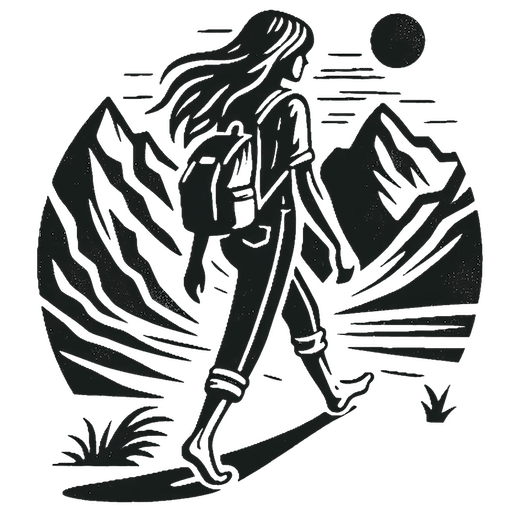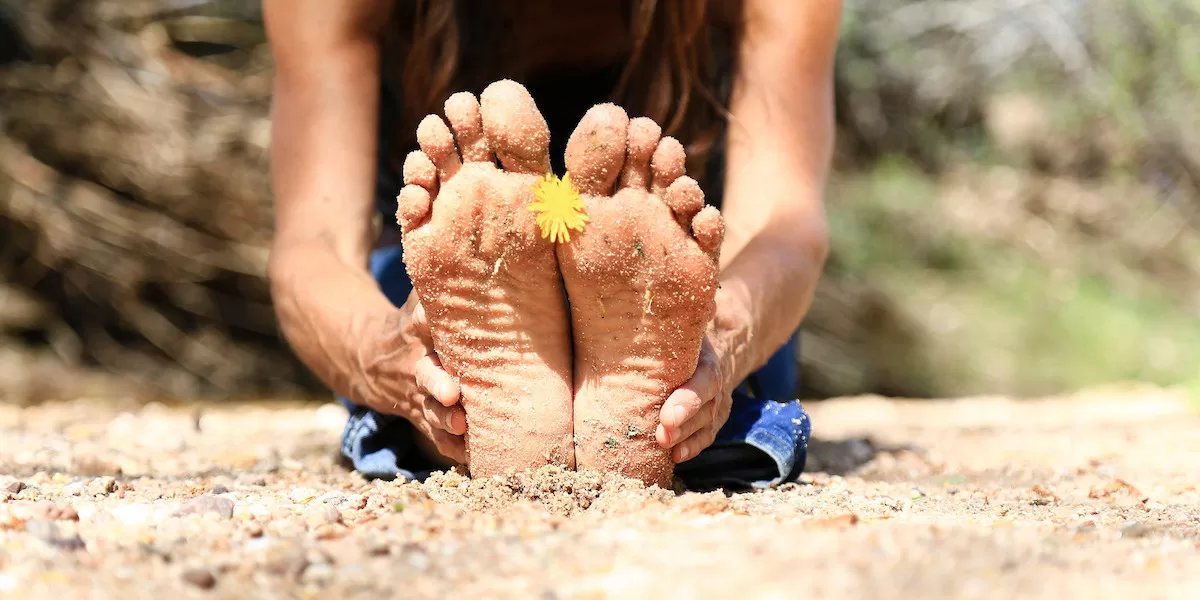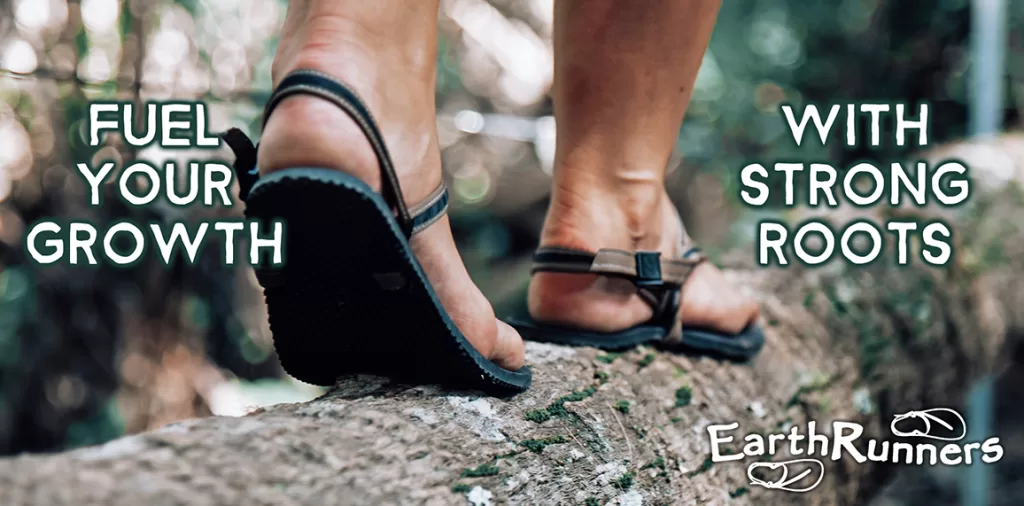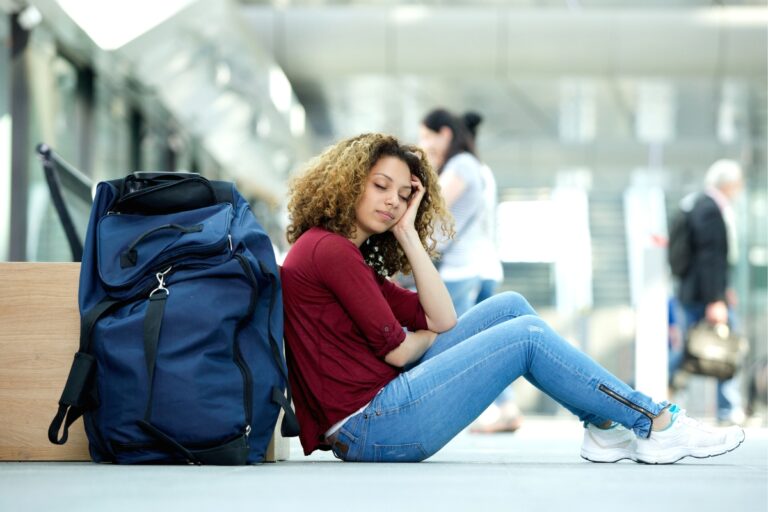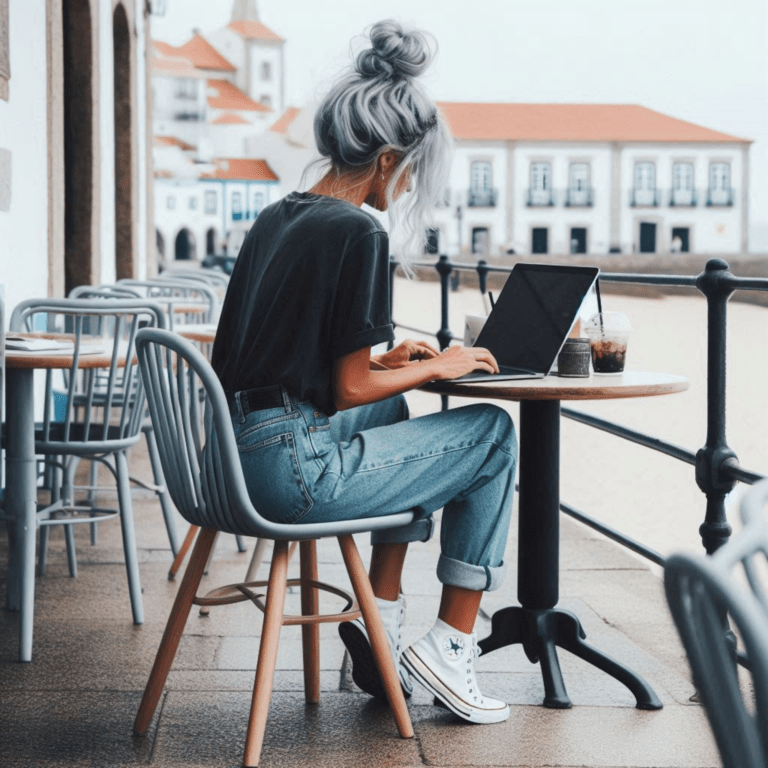The Barefoot Lifestyle: Reconnecting with Nature and Enhancing Health
In an era dominated by cushioned shoes and paved surfaces, a growing movement is encouraging people to kick off their footwear and reconnect with the earth beneath their feet. This comprehensive exploration of the barefoot lifestyle delves into the science, benefits, and practical aspects of embracing a more natural approach to walking, running, and living.
The Human Foot: A Marvel of Evolution
The human foot is a remarkable structure, honed by millions of years of evolution to support our unique bipedal locomotion. To truly appreciate the barefoot lifestyle, it’s essential to understand the complexity and capability of our feet.
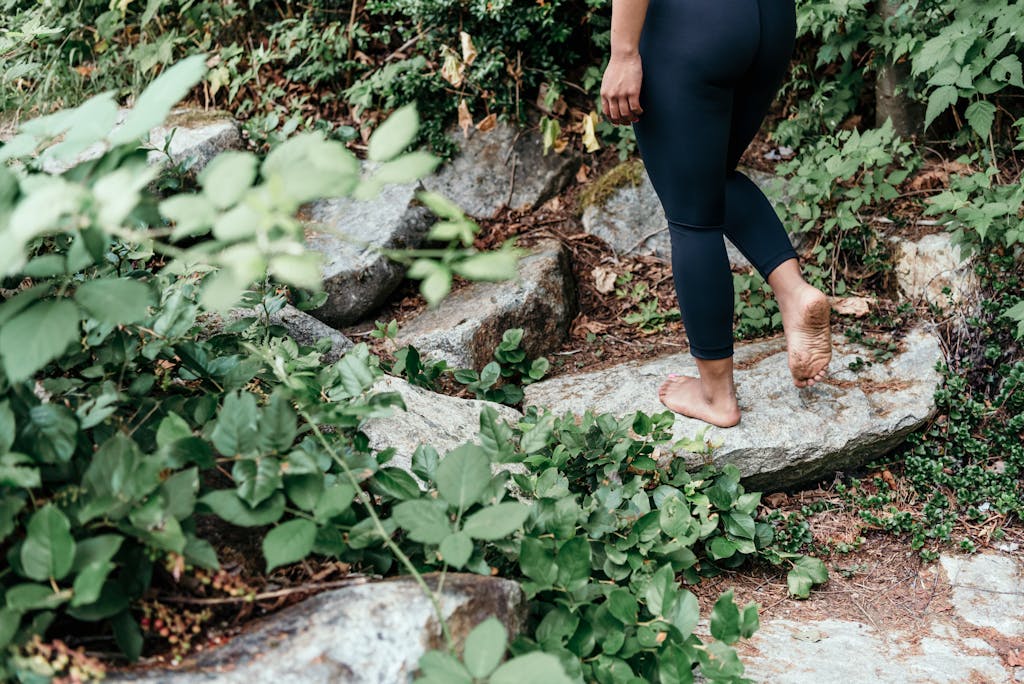
Structure and Function
Each foot contains 28 bones, 33 joints, and 112 ligaments, orchestrated by 13 extrinsic and 21 intrinsic muscles. This intricate network allows for a wide range of movements and adaptations to various surfaces and activities. The foot is typically divided into three main sections:
- Hindfoot: Composed of the talus and calcaneus (heel bone), this section forms the subtalar joint, crucial for side-to-side movement and shock absorption.
- Midfoot: Consisting of five tarsal bones (navicular, cuboid, and three cuneiforms), this area acts as a shock absorber and helps transfer force from the hindfoot to the forefoot.
- Forefoot: Including the metatarsals and phalanges (toe bones), this section is responsible for propulsion and balance during walking and running.
The arches of the foot – longitudinal and transverse – play a vital role in distributing body weight and absorbing shock. These arches are supported by ligaments and muscles, allowing the foot to function as both a rigid lever for propulsion and a flexible adapter to uneven terrain.
Evolution of the Human Foot
The journey of foot evolution is a fascinating tale that spans millions of years:
- Early hominids, such as Ardipithecus ramidus (4.4 million years ago), had feet adapted for both arboreal life and bipedal locomotion. Their feet featured a divergent big toe, useful for grasping tree branches.
- Australopithecus afarensis (3.9 to 2.9 million years ago) showed a more human-like foot structure, with a non-divergent big toe and the beginnings of arches, indicating increased adaptation to bipedal walking.
- Homo habilis and Homo erectus (2.3 to 0.7 million years ago) exhibited further refinements, including more pronounced arches and longer legs, suggesting improved efficiency in bipedal locomotion.
- The emergence of Homo sapiens (around 300,000 years ago) saw the modern human foot structure, with high, strong arches, aligned toes, and a non-grasping big toe.

Recent research has shed new light on foot evolution. A study published in Nature in 2020 by DeSilva et al. suggests that a human-like transverse arch may have evolved over 3.5 million years ago, much earlier than previously thought. This development likely played a crucial role in the evolution of human bipedalism, providing a rigid lever for more efficient walking and running.
The Benefits of Walking Barefoot
Proponents of the barefoot lifestyle argue that reconnecting our feet with the earth can lead to numerous health benefits. While more research is needed to fully understand these effects, several potential advantages have been identified:
1. Improved Posture and Balance
Walking barefoot can lead to significant improvements in posture and balance. When we walk without shoes, we naturally adopt a more upright posture and engage more muscles throughout our legs and core. A study published in the Journal of Bodywork and Movement Therapies in 2015 found that barefoot walking improved dynamic balance in healthy adults.
The increased sensory input from the soles of our feet when walking barefoot enhances proprioception – our awareness of body position in space. This heightened awareness can lead to better overall balance and coordination, potentially reducing the risk of falls, especially in older adults.
2. Enhanced Foot Strength and Flexibility
Regular barefoot walking and running can significantly strengthen the muscles in our feet and lower legs. A study published in the Journal of Sport and Health Science in 2014 found that barefoot running activated the intrinsic foot muscles more than running in conventional shoes.
Key muscles and structures that benefit from barefoot activities include:
- Intrinsic foot muscles (such as the abductor hallucis and flexor digitorum brevis)
- Tibialis anterior tendon
- Plantar fascia
- Achilles tendon
Strengthening these structures can help prevent common foot problems like plantar fasciitis and flat feet.
3. Stress Reduction through Grounding
“Grounding” or “earthing” refers to the practice of connecting the human body directly to the earth’s surface. Proponents believe this connection can have positive effects on health by allowing the body to absorb electrons from the earth, which may help combat free radicals and reduce inflammation.
While more rigorous scientific research is needed, some studies have suggested potential benefits of grounding:
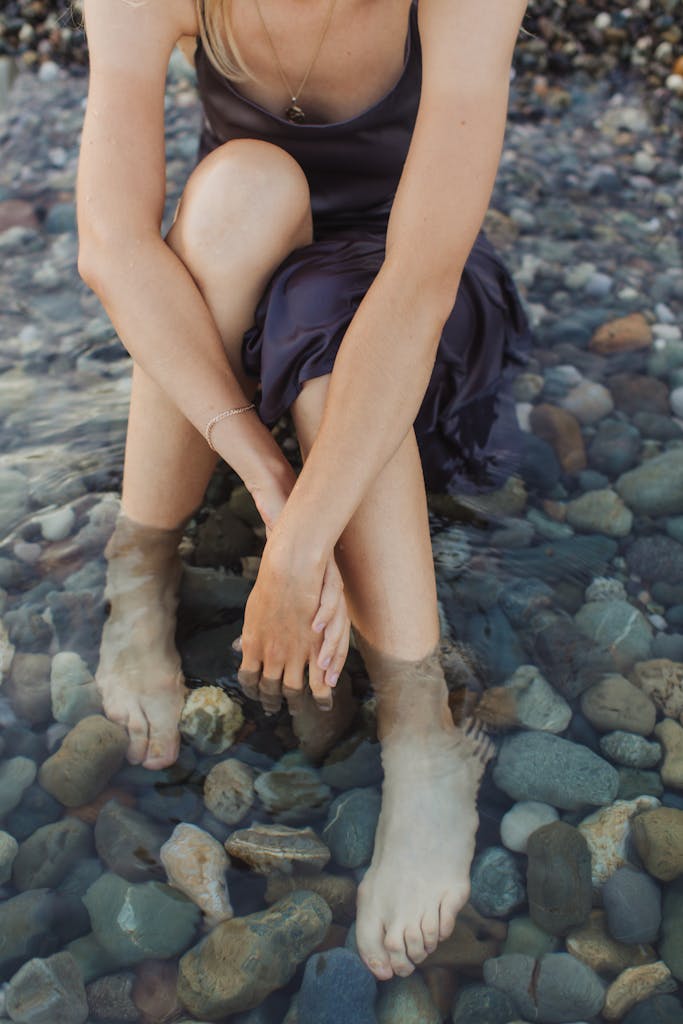
- A 2004 study published in the Journal of Alternative and Complementary Medicine found that grounding during sleep reduced nighttime levels of cortisol and improved subjective reports of sleep quality, pain, and stress.
- A 2015 study in the Journal of Inflammation Research suggested that grounding may help reduce inflammation and improve wound healing.
4. Potential Cardiovascular Benefits
Some research has indicated that grounding may have positive effects on cardiovascular health. A 2018 study published in the journal Alternative Therapies in Health and Medicine found that long-term, self-administered grounding therapy might help reduce blood pressure levels in individuals with hypertension.
While these results are promising, it’s important to note that more extensive research is required to confirm the cardiovascular benefits of grounding and barefoot living.
Transitioning to a Barefoot Lifestyle
For those interested in exploring the barefoot lifestyle, a gradual transition is key to avoiding injury and allowing the feet to adapt. Here’s a comprehensive guide to getting started:
- Start Indoors: Begin by walking barefoot around your home for short periods each day. This allows your feet to start strengthening in a safe, controlled environment.
- Gradual Outdoor Exposure: Once comfortable indoors, start venturing outside. Begin with soft, natural surfaces like grass or sand. Start with just a few minutes and gradually increase the duration.
- Varied Terrain: As your feet become stronger, introduce more varied terrain. Walk on pebbles, wood chips, and eventually rougher surfaces like asphalt or concrete. This helps toughen the soles of your feet and improves proprioception.
- Mindful Walking: Pay close attention to how you walk. Aim for a midfoot or forefoot strike rather than heel striking. This helps distribute impact forces more evenly and engages more muscles in your feet and legs.
- Listen to Your Body: It’s normal to experience some soreness as your feet adapt, but stop if you experience pain. Give your feet time to rest and recover between barefoot sessions.
- Consider Minimalist Shoes: As an intermediate step, you might want to try minimalist or “barefoot” shoes. These provide some protection while still allowing for natural foot movement. Start by wearing them for short periods and gradually increase.
- Foot Exercises: Incorporate specific foot strengthening exercises into your routine. Examples include toe spreads, short foot exercises, and calf raises.
- Be Patient: The transition to barefoot living can take several months. Don’t rush the process – give your feet time to adapt and strengthen.
Foot Care for Barefoot Enthusiasts
Adopting a barefoot lifestyle doesn’t mean neglecting foot care. In fact, proper foot maintenance becomes even more crucial. Here are some essential foot care practices for barefoot enthusiasts:
Mineral Soaks
Soaking feet in mineral-rich solutions can help soothe tired feet, soften skin, and promote overall foot health. I use something like this Cedar Foot Bath. Some beneficial soaks include:
- Mineral Bath: Epsom salt (magnesium sulfate), Dead Sea Salt, Himalayan Pink Salt can help reduce inflammation and soften calluses. Dissolve 1 cup (equal parts) in warm water and soak for 15-20 minutes.
- Apple Cider Vinegar Soak: Known for its antibacterial properties, apple cider vinegar can help prevent foot odor and fungal infections. Mix 1 part vinegar with 2 parts warm water.
Cold Therapy
Ice baths or cold water immersion can help reduce inflammation and provide pain relief, especially after long walks or runs.
1. Reduces Inflammation and Swelling
- Mechanism: Cold immersion causes vasoconstriction, narrowing blood vessels to reduce blood flow and inflammation. A 2020 study in Frontiers in Physiology found localized cold therapy effective for reducing post-exercise inflammation in athletes.
- Foot-Specific: Cooling the feet can alleviate swelling caused by plantar fasciitis, prolonged standing, or injury.
2. Pain Relief
- Gate Control Theory: Cold numbs nerve endings, blocking pain signals. A 2018 meta-analysis in Sports Medicine confirmed cold therapy’s efficacy for acute pain management.
- Foot Conditions: Effective for plantar fasciitis, Achilles tendonitis, and arthritis pain.
3. Improves Circulation
- Reactive Hyperemia: After cold exposure, blood vessels dilate (vasodilation), increasing blood flow. A 2017 study in Journal of Applied Physiology showed cold-water foot immersion improved microcirculation.
- Cold-to-Warm Contrast: Alternating cold and warm foot soaks (10°C/50°F → 40°C/104°F) enhances circulation, benefiting those with Raynaud’s syndrome or diabetes (under medical supervision). Ending on cold is recommended.
4. Energizes Nervous System
- Vagus Nerve Stimulation: Cold exposure activates the vagus nerve, which regulates stress responses. A 2021 Nature study linked foot-specific cold therapy to reduced sympathetic nervous system activity.
- Mental Alertness: Cold feet immersion triggers a “shock” response, releasing norepinephrine (20-30% increase), improving focus and mood.
5. Accelerates Recovery
- DOMS Reduction: A 2019 Journal of Strength and Conditioning Research trial found 10–15-minute cold foot baths reduced delayed-onset muscle soreness (DOMS) in runners by 30%.
- Metabolic Waste Clearance: Cold stimulates lymphatic drainage, flushing lactic acid from fatigued foot muscles.
6. Improves Skin and Nerve Health
- Nerve Sensitivity: Cold exposure increases BDNF (brain-derived neurotrophic factor), promoting nerve repair. Beneficial for neuropathy patients (per 2022 Neural Regeneration Research).
- Callus Management: Regular cold soaks soften thickened skin, reducing cracking risk.
Methods for Foot-Specific Cold Therapy
- Ice Water Foot Bath
- 10–15°C (50–59°F) water, 10–15 minutes. Add Epsom salts for magnesium absorption.
- Cold Packs or Frozen Water Bottles
- Roll feet over frozen bottles to combine cold therapy with massage.
- Snow or Cold Ground Walking
- A 2021 Wilderness & Environmental Medicine study noted improved circulation in hikers walking barefoot on snow.
- Cold-to-Warm Contrast Therapy
- Alternate 1–2 minutes cold (10°C/50°F) and warm (40°C/104°F) soaks for 3–5 cycles.
Safety Notes
Pair with foot massage or toe stretches to maintain flexibility.
Avoid if you have Raynaud’s disease, neuropathy, or poor circulation without medical approval.
Limit sessions to 15 minutes to prevent tissue damage.
- Fill a basin with cold water and add ice cubes.
- Immerse your feet for 10-15 minutes.
- Gently dry your feet and allow them to warm up naturally.
Cold therapy can be particularly beneficial alternating with Mineral Baths.
Skin Care
Regular skin care is crucial for maintaining healthy feet:
- Moisturizing: Apply a natural moisturizer like coconut oil or shea butter daily to prevent dry, cracked skin.
- Exfoliation: Gently exfoliate your feet once a week using a pumice stone or foot scrub to remove dead skin cells.
- Nail Care: Keep toenails trimmed straight across to prevent ingrown nails.
- Callus Management: While some callus formation is normal and protective for barefoot walkers, excessive buildup should be gently filed down.

Barefoot-Friendly Footwear
While the ultimate goal of the barefoot lifestyle is to go shoeless as much as possible, there are times when some form of foot protection is necessary. Fortunately, there are footwear options that mimic the barefoot experience:
Minimalist Shoes
Minimalist shoes are designed to provide minimal interference with the foot’s natural movement. Key features include:
- Thin, flexible soles (usually 3-10mm thick)
- Zero drop (no difference in height between heel and toe)
- Wide toe box to allow toes to spread naturally
- Lightweight construction
Popular brands in this category include:
- Whiten: A wide variety of inexpensive very comfortable casual and athletic shoes. My personal Favorite
- Viba: Gorgeous shoes made in Finland. Leather, Linen, Wool.
- Raum: Natural foot shape and zero-drop sole for the ultimate grounded barefoot shoe.
- Earthing Harmony: Casuals and Sandals.
- Merrell Barefoot: Offers a range of minimalist shoes for various activities, from casual wear to trail running.
- Xero Shoes: Provides ultra-minimalist sandals and shoes, many with a “barefoot feel” warranty.
- Vivobarefoot: Offers a wide range of minimalist shoes for different activities and environments.
Barefoot Sandals
For those who prefer an even more open design, barefoot sandals provide minimal coverage while still offering some protection. Key features include:
- Ultra-thin soles (often 4-8mm thick)
- Minimal strapping systems
- Zero drop design
- Often made with natural or recycled materials
Popular brands in this category include:
- Earth Runners: My Absolute favorite!! Offers grounding sandals with copper inserts for earthing benefits. I have walked/hiked/run thousands of miles in mine.
- Unshoes: Provides minimalist sandals with interchangeable straps for customization.
- Luna Sandals: Inspired by the running sandals of the Tarahumara people, known for their long-distance running abilities.
Socks for Barefoot and Grounding
When it comes to wearing socks with barefoot-style shoes or for grounding purposes, the material choice is crucial:
Wool Socks vs. Cotton Toe Socks: Which Are Better for Grounding?
- Wool Socks: Wool, especially Creeper merino wool, is an excellent choice for grounding. It’s a natural fiber that retains some moisture, enhancing conductivity. Merino wool is soft, breathable, and effective at wicking moisture, making it ideal for grounding when paired with grounding footwear. Brands like Injinji and Smartwool offer merino wool options specifically designed for barefoot shoes.
- Cotton Toe Socks: Cotton is another natural fiber that allows some electron transfer, particularly when thin and slightly moist. Toe socks are beneficial for barefoot-style shoes as they allow toes to splay naturally. However, cotton tends to absorb and retain more moisture than wool, which could lead to discomfort over time. Brands like Vibram and Injinji offer cotton toe sock options.
Verdict: While both materials can work for grounding, wool socks (especially merino) are generally better due to their superior moisture-wicking properties and comfort in various temperatures. For those seeking enhanced grounding benefits, consider specialized grounding socks with conductive silver threads, such as those offered by Earthing.com.
DIY: Adding Copper Grounding Grommets to Regular Barefoot Shoes
If you own minimalist or barefoot shoes without built-in grounding capabilities, you can modify them by adding copper grommets. This DIY approach allows you to enjoy the benefits of grounding without purchasing new shoes. Here’s a step-by-step guide:
- Materials Needed:
- Copper grommets (available from online retailers like EarthRunners)
- A leather punch or drill
- Hammer or grommet setter
- Conductive thread (optional)
- Multimeter (for testing conductivity)
- Steps:
1.Identify the sole area where your foot makes the most contact, typically under the ball of the foot.
2 Use a leather punch or drill to create a small hole in the sole. Ensure the hole is slightly smaller than the grommet for a tight fit.
3 Insert the copper grommet into the hole.
4 Use a hammer or grommet setter to secure the grommet in place. Make sure it’s flush with the sole surface.
5 For additional conductivity, you can sew conductive thread from the grommet to the insole area where your foot will make contact.
- Copper grommets (available from online retailers like EarthRunners)
- Tips:
- Ensure the copper grommet makes direct contact with the ground when wearing the shoes.
- Test conductivity with a multimeter to confirm proper grounding. Touch one probe to the inside of the shoe where your foot contacts and the other to the outside of the grommet.
- Consider adding multiple grommets for better conductivity, especially if you’re modifying shoes for running or other high-impact activities.
- Regularly check the grommets for wear and tear, replacing them as needed.
- Ensure the copper grommet makes direct contact with the ground when wearing the shoes.
This modification allows you to transform your favorite barefoot shoes into grounding footwear, combining the benefits of minimalist design with the potential health advantages of earthing.
Barefoot Activities
Hiking and Backpacking
Barefoot hiking can provide a unique sensory experience and connection with nature. However, it requires careful preparation and gradual adaptation:
- Start Small: Begin with short hikes on gentle, familiar trails. Gradually increase distance and difficulty as your feet adapt.
- Choose Your Terrain Wisely: Start with softer surfaces like forest paths or sandy trails before attempting rocky terrain.
- Be Aware of Hazards: Pay close attention to the ground, watching for sharp rocks, thorns, or other potential dangers.
- Foot Protection: Consider carrying minimalist hiking sandals for particularly challenging sections of trail or for creek crossings.
- Foot Care on the Trail: Bring along a small first aid kit with items like antiseptic wipes and bandages. Take regular breaks to check your feet for any issues.
- Trekking Poles: Using trekking poles can help distribute your weight and provide extra stability on uneven terrain.
- Leave No Trace: Be mindful of your environmental impact. Stick to established trails to minimize erosion and protect vegetation.
Running
Barefoot running has gained popularity in recent years, with proponents claiming it can reduce injuries and improve running form. Here’s what you need to know:
- Form is Key: Focus on a forefoot or midfoot strike rather than heel striking. This helps distribute impact forces more evenly.
- Start Slowly: Begin with very short distances (100-200 meters) on soft surfaces like grass or a running track.
- Gradual Progression: Increase your barefoot running distance by no more than 10% per week to allow your feet and legs to adapt.
- Listen to Your Body: Pay attention to any pain or discomfort. It’s normal to feel some soreness as you adapt, but sharp pain is a sign to stop and rest.
- Varied Surfaces: As you progress, introduce different surfaces to your runs. This helps strengthen your feet and improve proprioception.
- Complementary Exercises: Incorporate foot strengthening exercises and stretches into your routine to support your barefoot running practice.
- Consider Minimalist Running Shoes: For longer distances or rougher terrain, minimalist running shoes can provide some protection while still allowing for natural foot movement.
International Travel
Traveling barefoot can present unique challenges and cultural considerations:
- Research Local Customs: In some cultures, going barefoot is common and accepted, while in others it may be considered disrespectful. Research your destination’s norms before traveling.
- Airport Security: Be prepared to put on shoes for security checks. Slip-on minimalist shoes can be convenient for this purpose.
- Varied Surfaces: International travel often exposes you to a wide range of surfaces. Be prepared for everything from smooth marble floors to rough cobblestones.
- Hygiene Considerations: In some areas, public sanitation may be a concern. Carry a small bottle of hand sanitizer or wipes for your feet.
- Pack Versatile Footwear: Bring a pair of lightweight, collapsible minimalist shoes for situations where footwear is required, such as restaurants or religious sites.
- Weather Adaptations: Be prepared for extreme temperatures. In hot climates, surfaces can become scorching, while cold climates may require warm socks or boots.
- First Aid Kit: Include items specific to foot care, such as blister pads, antiseptic cream, and small bandages.
- Language Preparation: Learn how to explain your barefoot lifestyle in the local language, in case you need to communicate with locals or officials about your choices.

Overcoming Challenges and Misconceptions
Adopting a barefoot lifestyle can come with its share of challenges and misconceptions. Here’s how to address some common issues:
- Safety Concerns:
- Be aware of potential hazards like sharp objects, extreme temperatures, or contaminated surfaces.
- Develop a keen awareness of your surroundings and where you step.
- Consider using minimalist shoes in high-risk areas.
- Be aware of potential hazards like sharp objects, extreme temperatures, or contaminated surfaces.
- Hygiene Issues:
- Regularly wash and inspect your feet.
- Use hand sanitizer or wipes on your feet when necessary.
- Be mindful of local health regulations in public spaces.
- Regularly wash and inspect your feet.
- Social Norms:
- Be prepared to face questions or skepticism from others.
- Educate yourself on the benefits of barefoot living so you can articulate your choices clearly.
- Respect establishments that require shoes and carry a pair of minimalist shoes for such situations.
- Be prepared to face questions or skepticism from others.
- Legal Considerations:
- Be aware that some businesses may have “No Shirt, No Shoes, No Service” policies.
- Understand that there are generally no laws against walking barefoot everywhere or driving barefoot, despite common misconceptions.
- Be aware that some businesses may have “No Shirt, No Shoes, No Service” policies.
- Weather Adaptations:
- In cold weather, gradually acclimate your feet and consider using minimalist shoes with thermal socks.
- For hot surfaces, develop techniques like the “barefoot shuffle” or seek shaded paths.
- In cold weather, gradually acclimate your feet and consider using minimalist shoes with thermal socks.
- Medical Concerns:
- Consult with a healthcare professional before adopting a barefoot lifestyle, especially if you have pre-existing foot conditions or diabetes.
- Be prepared to advocate for yourself in medical settings where barefoot living may be misunderstood.
- Consult with a healthcare professional before adopting a barefoot lifestyle, especially if you have pre-existing foot conditions or diabetes.
Embracing the Barefoot Journey
The barefoot lifestyle offers a unique opportunity to reconnect with our evolutionary roots and potentially enhance our overall health and well-being. By understanding the structure and evolution of our feet, appreciating the potential benefits of barefoot living, and taking proper care of our feet, we can embark on a journey that may lead to improved health, greater body awareness, and a deeper connection with the world around us.
As with any lifestyle change, it’s important to approach barefoot living gradually and listen to your body. The transition may take time, and it’s crucial to be patient with yourself as your feet and body adapt. Remember that barefoot living is not an all-or-nothing proposition – even incorporating small amounts of barefoot time into your daily routine can be beneficial.
While more research is needed to fully understand all the benefits of barefoot living, many enthusiasts report improved posture, stronger feet, reduced pain, and a greater sense of connection to the earth. By combining the ancient wisdom of our barefoot ancestors with modern scientific understanding, we can forge a path towards more natural, healthy living in our modern world.
Whether you’re taking your first steps on grass, modifying your shoes for better grounding, or planning a barefoot-friendly travel adventure, remember that each step is a part of your unique journey. Embrace the sensations, learn from the challenges, and enjoy the freedom that comes with reconnecting your feet to the earth.
Further Reading and Resources
For those interested in delving deeper into the barefoot lifestyle, consider exploring these resources:
- “Born to Run” by Christopher McDougall – An exploration of the Tarahumara Indians and the benefits of barefoot running.
- “Earthing: The Most Important Health Discovery Ever!” by Clinton Ober, Stephen T. Sinatra, and Martin Zucker – A comprehensive look at the science behind grounding.
- “Whole Body Barefoot: Transitioning Well to Minimal Footwear” by Katy Bowman – A guide to safely transitioning to a barefoot lifestyle.
- “The Barefoot Book: 50 Great Reasons to Kick Off Your Shoes” by Daniel Howell – An accessible introduction to the benefits of going barefoot.
- The Society for Barefoot Living (www.barefooters.org) – An organization dedicated to promoting barefoot living and addressing legal and social issues.
- Barefoot Hiking Groups – Look for local groups or online communities that organize barefoot hikes and provide support for beginners.
- Scientific Journals – For those interested in the research behind barefoot living, consider exploring journals like “Gait & Posture” and “Journal of Foot and Ankle Research” for the latest studies.
By embracing the barefoot lifestyle, you’re not just changing your footwear – you’re embarking on a journey that can transform your relationship with your body and the world around you. Take it one step at a time, and enjoy the path beneath your feet.
